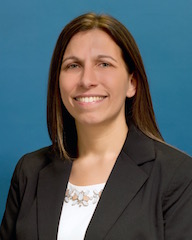News Release
Mission Critical: How Humans and Robots Can Team up in Uncertain Environments
UC San Diego roboticist leads $7.5M grant on human-robot teaming
 |
| Laurel Riek is one of two UC San Diego lead researchers on a $7.5M grant on human-robot teaming. |
May 20, 2022-- In the midst of a medical emergency or disaster response, how can humans and robots work together more effectively?
That’s the question University of California San Diego roboticist Laurel Riek and a team of researchers are seeking to answer with a new $7.5 million Department of Defense Multidisciplinary University Research Initiative (MURI) award.
Riek, an associate professor in the Department of Computer Science and Engineering in the Jacobs School of Engineering and the director of the Healthcare Robotics Lab at UC San Diego, will lead the project that seeks to advance research in robotics and autonomy, with the goal of aiding human teams working in critical environments.
She is one of two UC San Diego researchers to lead a MURI project in this year’s round of funding. Three other teams of which UC San Diego researchers are a part also received MURI awards. (Read more about UC San Diego FY22 MURI awards.)
“It is important that robots can understand the goals, activities, and intentions of human teams, and their context, to be useful teammates,” she said. The trans-disciplinary team joins the fields of robotics, artificial intelligence (AI), cognitive science, and human factors to investigate the science of human-agent teaming (HAT).
Riek’s MURI project will explore how teams reason, coordinate and trust, particularly regarding how teams change over time. It will address key questions in HAT, including:
- Modeling and operationalizing team mental models, for example, looking at how human and robotic teammates can collaboratively achieve a shared understanding of knowledge of tasks and the environment.
- Understanding how team dynamics change over time, including when robots take actions to calibrate and maintain their trust in one another, when they jointly act together, and when they engage in shared decision making. Researchers will study teaming temporally, both in real time and over time.
- Exploring how two key mediators, coordination and team cognition, affect team performance. Both are understudied in HAT research, yet very important to team outcomes.
“By creating new methods that model team evolution both dynamically and over time and by scientifically establishing how autonomy affects human teammates, this work will yield new insights for HAT in uncertain environments,” said Riek, who has been studying human robot teaming in safety-critical environments for over a decade.
Ultimately, this project will create innovative, cognitively-informed conceptual frameworks and computational models of teaming; establish core elements of a new interdisciplinary science of human-agent teams; accelerate the advancement of HAT in mission critical environments; and pioneer rapid prototyping and rigorous field testing of new guidelines and interventions for HAT design.
Other researchers on the project include Susan Simkins, Penn State University; Ericka Rovira, U.S. Military Academy; Thomas Griffiths, Princeton University; Angela Yu, UC San Diego; Francesco Bullo, UC Santa Barbara; Vaibhav Srivastva, Michigan State University; and Vijay Gupta, University of Notre Dame.
Media Contacts
Ioana Patringenaru
Jacobs School of Engineering
858-822-0899
ipatrin@ucsd.edu
Katie Ismael
Qualcomm Institute
858-246-5898
kismael@eng.ucsd.edu